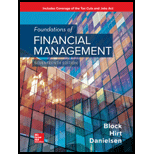
a.
To determine: The likely price of the floating-rate
Introduction:
Preferred stock:
It is a type of security that represents ownership of the company. The holders of such stock are entitled to receive a fixed dividend amount before it is paid to the common shareholders of the company.
Floating Rate:
It refers to a variable interest rate that fluctuates or changes over a period of time as per the market and may be difficult to predict in the near future.
b.
To calculate: The price of the straight preferred stock for Barnes Air Conditioning Inc.
Introduction:
Straight preferred stock:
It refers to those preferred stocks that cannot be converted into common stocks. It is also referred to as ‘non-cumulative’ because if dividend is not declared or paid up in time, the past dividends will never be received.
Cost of preferred stock:
It refers to the amount of dividend paid annually by a company on its preferred stock. Such dividend is not tax deductible and can be calculated by dividing the annual preferred dividend with the current market price of the preferred stock.
Want to see the full answer?
Check out a sample textbook solution
Chapter 17 Solutions
EBK FOUNDATIONS OF FINANCIAL MANAGEMENT
- Nikes annual balance sheet and income statement for 2022-2023 and 2024arrow_forwardWhat is the value at the end of year 3 of a perpetual stream of $70,000 semi-annual payments that begins at the end of year 7? The APR is 12% compounded quarterly.arrow_forwardFirm A must pay $258,000 to firm B in 10 years. The discount rate is 16.44 percent per year. What is the present value of the cash flow associated with this arrangement for firm A? -I got the answer of 56331.87773=56332 (rounded to the nearest dollar), but it says incorrect.arrow_forward
- Suppose you have two histograms: one where the mean equals the median, and one where the mean is different from the median. How would you expect the two histograms to differ.arrow_forward(a) The variables have been stripped of their names. Which one do you think is "household income" ?(b) Calculate the mean, median, and standard deviation of household income. Do these numbers fit with your expectations? (c) Suppose you have two histograms: one where the mean equals the median, and one where the mean is different from the median. How would you expect the two histograms to differ?arrow_forwardJanet Foster bought a computer and printer at Computerland. The printer had a $860 list price with a $100 trade discount and 210210 , n30n30 terms. The computer had a $4,020 list price with a 25% trade discount but no cash discount. On the computer, Computerland offered Janet the choice of (1) paying $150 per month for 17 months with the 18th payment paying the remainder of the balance or (2) paying 6% interest for 18 months in equal payments. Assume Janet could borrow the money for the printer at 6% to take advantage of the cash discount. How much would Janet save? Note: Use 360 days a year. Round your answer to the nearest cent.arrow_forward
- Don't used Ai solutionarrow_forwardConsider the following cash flows on two mutually exclusive projects for the Bahamas Recreation Corporation (BRC). Both projects require an annual return of 14 percent. New Submarine Deepwater Fishing Year Ride 0 -$875,000 1 330,000 2 480,000 3 440,000 -$1,650,000 890,000 730,000 590,000 a-1. Compute the IRR for both projects. (Do not round intermediate calculations and enter your answers as a percent rounded to 2 decimal places, e.g., 32.16.) Deepwater Fishing Submarine Ride 19.16 % 17.50% a-2. Based on the IRR, which project should you choose? Deepwater Fishing Submarine Ride b-1. Calculate the incremental IRR for the cash flows. (Do not round intermediate calculations and enter your answer as a percent rounded to 2 decimal places, e.g., 32.16.) Incremental IRR 14.96 % b-2. Based on the incremental IRR, which project should you choose? Submarine Ride Deepwater Fishingarrow_forwardWhat is the possibility that cases are not readily bounded but may have blurry definitions? How to address Robert Yin statement and how to resolve the ‘not readily bound’ case? Please help explain.arrow_forward
 Intermediate Financial Management (MindTap Course...FinanceISBN:9781337395083Author:Eugene F. Brigham, Phillip R. DavesPublisher:Cengage Learning
Intermediate Financial Management (MindTap Course...FinanceISBN:9781337395083Author:Eugene F. Brigham, Phillip R. DavesPublisher:Cengage Learning
